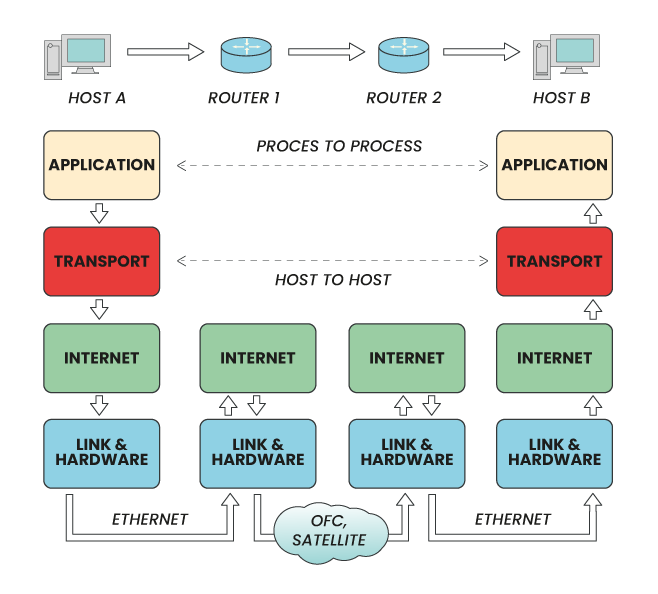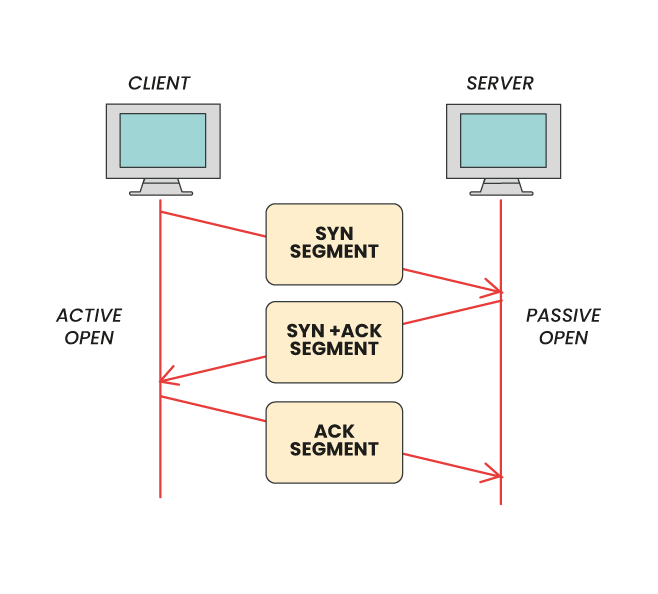We use cookies to make your experience better. To comply with the new e-Privacy directive, we need to ask for your consent to set the cookies. Learn more.
TCP/IP Protocols Explained

What is TCP/IP?
TCP/IP enables communication end-to-end for the internet, defining how data is packetized and addresses the transmission, routing, and reception of packets. Although used together, the TCP and IP protocols have distinct purposes.
What is TCP?
TCP (Transmission Control Protocol) determines how applications create communication channels across networks and manages the assembly of message packets before their transmission over the internet. It provides a structure for how packets are reassembled once they arrive at their destination.
What is IP?
IP (Internet Protocol) handles the formatting of addresses and how packets are routed. Once packets arrive at a gateway computer, the IP address is used to confirm where the message will be forwarded.
Four Layers of TCP/IP
1. Application layer. This layer handles communication node-to-node from user interfaces. It uses additional protocols such as FTP, HTTP, HTTPS, NTP, and TELNET.
2. Transport or host-to-host layer. TCP within the host-to-host layer keeps data delivery error-free.
3. Internet layer. The Internet Layer sends the data packets to their destination, comprising the logic of all transmissions.
4. Link layer. This is the physical transmission layer where the IP address is added, and the data is transmitted between two connected devices within a network.


The system allows for the transportation of vast amounts of data in packets. These packets may take different routes to the end destination, allowing faster resolution for packets that encounter problems or corruption in transit.
The functionality of the layer structure standardizes communication and frees up hardware and software resources. Each packet must traverse all four layers outgoing and in incoming, with the arriving data is displayed in its original format.


TCP/IP is effective in the two-way, fast transmission of data over internet connections based on its use of a three-way “handshake”.
Once the connection is established, the device originating the communication and the server synchronize (SYN) packets and acknowledge (ACK) them before the commencement of communication. Then, connectivity is negotiated, separated, and transferred.
The Various Protocols of TCP/IP Protocol Suite


Application Layer
HTTP (HyperText Transfer Protocol) - A foundation protocol for data distribution in the World Wide Web. The hyperlinked files you browse in the Network by clicking the links are the HTTP implementations.
HTTPS (HTTP Secure) - An extension of HTTP for secure communication. You may have noticed a green pane in the browser address bar as an indication of a secure site.
FTP (File Transfer Protocol) - A standard protocol for transferring files on the Network.
Telnet – A protocol for remote logging a host with a text-based interface and bi-directional communication utilizing virtual terminal communication.
SSH (Secure Shell) - An encrypted method of remote logging, generally used for remote command execution in a device.
POP (Post Office Protocol) - Protocol for receiving the emails. The commonly used version is POP-3.
SMTP (Simple Mail Transfer Protocol) - Standard protocol for sending emails.
SNMP (Simple Network Management Protocol) - A protocol for managing devices in a network. The network devices like a router, switch, firewalls, etc. managed from a centralized console.
DNS (Domain Name System) - Protocol for a domain name to IP address resolution.
Transport Layer
TCP (Transmission Controlled Protocol) - It is One of the transport layer protocols. TCP is a connection-oriented and reliable protocol used in TCP/IP protocol suite.
UDP (User Datagram Protocol) - Another well-known transport layer protocol. It is connectionless, unreliable, and suitable for real-time applications.
Internet Layer
IPv4 and IPv6 (Internet Protocol v4 & v6) - IP is the network layer protocol for logical addressing and routing the packets over the networks.
ICMP (Internet Control Message Protocol) - It is a supporting protocol in the IP layer. It is used for displaying the error messages, indicating the connection status, etc. The examples are Ping, tracert, etc. commands. ICMPv6 is the implementation of ICMP in IPv6.
IPSec (Internet Protocol Security) - It is a security add-on upon IPv4 and an integrated part of IPv6. The mechanism for encrypting the packets over an IP network. Also, the base of the secure connection like a Virtual Private Network (VPN).
IGMP (Internet Group Management Protocol) - Mostly used by the routers to manage the multicast groups in IPv4.
ARP (Address Resolution Protocol) - Protocol for mapping network to link-layer. It is used to get the MAC-address for a known IP address.
RARP (Reverse Address Resolution Protocol) - Reverse of ARP, a protocol used for mapping MAC address to an IP address. ARP sends IP to get MAC, whereas RARP sends MAC to get IP.
Link Layer
PPP (Point to Point Protocol) - PPP itself is a network layer protocol, but two extensions of PPP, viz. PPPoE and PPPoA, PPP over Ethernet, and PPP over ATM are link layer protocols for encapsulating PPP frames into Ethernet, and ATM respectively. These protocols are used by ISPs to deliver DSL lines.
SLIP (Serial Line Internet Protocol) - Encapsulation of IP over serial lines. It is mostly replaced by PPP.
LLDP (Link Layer Discovery Protocol) - Protocol used by network devices for advertising their various parameters. It is mostly used for network monitoring and management.
DLCI (Data Link Connection Identifier) - Identification of the virtual circuit used by Frame Relay.
HDLC (High-Level Data Link Control) - An extension of IBM’s SLDC (Synchronous Data Link Control) used in SNA (Systems Network Architecture). Allows transmission of frames over a synchronous or asynchronous serial link.
Conclusion
In conclusion, TCP/IP stands as the foundational framework enabling the intricate web of communication that defines the internet. This suite of protocols orchestrates the transmission, routing, and reception of data packets across networks, ensuring seamless end-to-end connectivity. Through its layered architecture, TCP/IP streamlines communication, optimizing resource utilization while maintaining reliability and efficiency.
At its core, TCP governs the establishment of communication channels and ensures error-free data delivery, while IP manages addressing and packet routing. The four layers of TCP/IP—application, transport, internet, and link—provide a structured approach to data transmission, accommodating a diverse array of protocols catering to various communication needs.
From HTTP facilitating web browsing to TCP's reliable data transfer and IP's routing capabilities, each protocol within the TCP/IP suite plays a crucial role in enabling diverse internet functionalities. Moreover, the suite's flexibility allows for the transmission of vast amounts of data through packets that can take multiple routes to their destination, enhancing speed and reliability.
Furthermore, TCP/IP's support for various protocols at different layers enables a wide range of applications, from secure file transfers with SSH to efficient email communication through SMTP. This versatility ensures that TCP/IP remains the cornerstone of internet communication, adapting to evolving technological needs and standards.
In essence, TCP/IP's enduring relevance lies in its ability to facilitate seamless, efficient, and secure communication across the global network of networks. As technology continues to advance, TCP/IP will undoubtedly remain fundamental, underpinning the interconnected digital landscape that defines the modern era.




